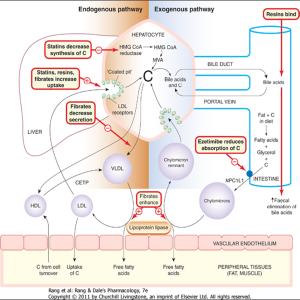2.14 Lipid Transport and Metabolism
John Smithson
Be able to:
- describe the exogenous pathway of lipid transport, detailing the role of chylomicrons and the process of dietary cholesterol absorption and transport to the liver and peripheral tissues.
- understand the endogenous pathway of cholesterol production and transport, explaining how VLDL and LDL function in delivering cholesterol from the liver to peripheral tissues and the impact of HMG-CoA reductase in cholesterol biosynthesis.
There are two potential sources of cholesterol. The exogenous pathway utalises dietary cholesterol consumed and absorbed via the small intestine. The endogenous pathway produces cholesterol via hepatic means.
Exogenous pathway (Transport of lipids from GI tract to liver)
Chylomicrons (‘kylo-microns’) are large particles which transport dietary cholesterol and fatty acids absorbed from the small intestine in the lymph and then blood to capillaries in the muscles and adipose tissue. They consist mainly of tryglycerides (85-95%) and are produced in the small intestine during absorption of a fatty meal. They are cleared from the bloodstream by lipoprotein lipase after 12-14hrs. Lipoprotein lipase then hydrolyses triglycerides and the tissues take up the resulting free fatty acids and glycerol.
The chylomicron remnants (still containing the cholesteryl esters) pass to the liver where they bind to receptors on hepatocytes and undergo endocytosis. Cholesterol liberated in the hepatocytes is stored, oxidised to bile acids, secreted unaltered in bile, or enters the endogenous pathway. The right hand side of the figure below shows the exogenous pathway. Note the movement of cholesterol to the liver and free fatty acids and glycerol to the peripheral tissues.

Endogenous pathway
Cholesterol and newly synthesised triglycerides are transported from the liver as VLDL (Very Low Density Lipoproteins) to muscle and adipose tissue. The triglycerides are cleaved off by lipoprotein lipase leaving Low Density Lipoproteins (LDL) – the role of LDLs is to transport cholesterol from the liver (initially in the form of VLDL and eventually cleaved to LDL) to peripheral tissues.
VLDLs contain a large amount of TG (50-65%) and Cholesterol (20-30%). Formed in liver from endogenously synthesised triglycerides. The triglyceride is hydrolysed to fatty acids and glycerol by lipoprotein lipase. The fatty acids and triglycerides enter the tissues. During this process, the lipoprotein particles become smaller and more dense and retain their cholesteryl esters to form LDL particles. LDL provides the source of cholesterol for incorporation into cell membranes and to synthesise steroids but the transport of excess cholesterol is also key in the development of atherosclerosis.
Endogenous pathway transport of liver-synthesised cholesterol to the peripheral tissues
The liver also produces cholesterol and this supply of cholesterol can be upregulated or down regulated in response to changes in plasma cholesterol availability. The liver produces cholesterol from Acetyl-CoA. Acetyl-CoA is metabolized to HMG-CoA and then to Mevalonate by the reducing enzyme HMG-CoA reductase.
This is the rate limiting step in the production of cholesterol and is an important target for the statin drug class which reduces endogenous production of cholesterol. The endogenously produced cholesterol is used with the exogenously sourced cholesterol and is used to form bile acid/salts, in the production of Vitamin D and transported to the peripheral tissues by VLDL and LDL.
The figure below shows the important steps in the endogenous production of cholesterol and the role of HMG CoA reductase in the rate limiting step of the formation of Mevalonate from HMG CoA.

📺 Watch video: Lipid transport and metabolism. (8:09 min)
COMMONWEALTH OF AUSTRALIA Copyright Regulations 1969 WARNING
This material has been reproduced and communicated to you by or on behalf of James Cook University in accordance with section 113P of the Copyright Act 1969 (Act).
The material in this communication may be subject to copyright under the Act. Any further reproduction or communication of this material by you may be the subject of copyright protection under the Act. Do not remove this notice.
